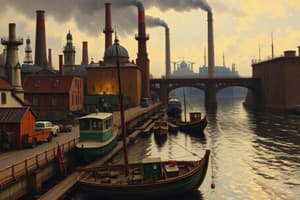Podcast
Questions and Answers
Was charakterisiert die Zeit der Industriellen Revolution hauptsächlich?
Was charakterisiert die Zeit der Industriellen Revolution hauptsächlich?
- Eine Rückkehr zur feudalen Wirtschaftsordnung
- Ein Übergang von handgefertigten Gütern zu maschinell hergestellten Produkten (correct)
- Eine Abnahme der Bevölkerungszahl aufgrund von Krankheiten
- Eine Abnahme des Energieverbrauchs in der Gesellschaft
Was war eine direkte Auswirkung der Industriellen Revolution auf die Bevölkerung?
Was war eine direkte Auswirkung der Industriellen Revolution auf die Bevölkerung?
- Eine Verringerung der Bevölkerung aufgrund von schlechten Lebensbedingungen
- Eine Erhöhung der Bevölkerung aufgrund verbesserter Lebensbedingungen (correct)
- Eine Stagnation der Bevölkerungszahl aufgrund wirtschaftlicher Unsicherheiten
- Eine Migration der Bevölkerung in ländliche Gebiete
Was kennzeichnet die kapitalistische Wirtschaftsordnung, die während der Industriellen Revolution entstand?
Was kennzeichnet die kapitalistische Wirtschaftsordnung, die während der Industriellen Revolution entstand?
- Gemeinschaftliches Eigentum an Produktionsmitteln
- Privateigentum an Kapitalgütern und Produktion von Waren für den Verkauf auf einem Markt (correct)
- Zentral gelenkte Wirtschaft ohne Marktwirtschaft
- Produktion von Gütern ausschließlich für den Eigenbedarf
Welcher Aspekt nahm während der Industriellen Revolution signifikant zu?
Welcher Aspekt nahm während der Industriellen Revolution signifikant zu?
Warum wurde die Massenproduktion während der Industriellen Revolution kritisiert?
Warum wurde die Massenproduktion während der Industriellen Revolution kritisiert?
Was kennzeichnete das industrielle System in Bezug auf seine Komplexität während der Industriellen Revolution hauptsächlich?
Was kennzeichnete das industrielle System in Bezug auf seine Komplexität während der Industriellen Revolution hauptsächlich?
Was war eine bedeutende Innovation im Bereich der Textilproduktion während der Industriellen Revolution?
Was war eine bedeutende Innovation im Bereich der Textilproduktion während der Industriellen Revolution?
Welche Rolle spielte die Dampfmaschine während der Industriellen Revolution hauptsächlich?
Welche Rolle spielte die Dampfmaschine während der Industriellen Revolution hauptsächlich?
Was waren einige der Verbesserungen in der Landwirtschaft während der Industriellen Revolution?
Was waren einige der Verbesserungen in der Landwirtschaft während der Industriellen Revolution?
Wer revolutionierte den Transportsektor mit der Erfindung des Automobils?
Wer revolutionierte den Transportsektor mit der Erfindung des Automobils?
Welchen Bereich revolutionierte die Industrielle Revolution NICHT?
Welchen Bereich revolutionierte die Industrielle Revolution NICHT?
Welchen Beitrag leistete die Industrielle Revolution hauptsächlich zur Gesellschaft?
Welchen Beitrag leistete die Industrielle Revolution hauptsächlich zur Gesellschaft?
Flashcards are hidden until you start studying
Study Notes
The Industrial Revolution
The Industrial Revolution was a transitional period in history that brought about a shift from handmade goods to those produced by machines. While the exact start and end dates are debated among scholars, it is generally regarded as spanning from around 1760 to 1840. This era marked a significant turning point in human history, leading to an increase in population, a higher standard of living, and the emergence of the capitalist economy.
Impact of the Industrial Revolution
-
Population Increase: The Industrial Revolution led to an increase in population due to improved living conditions and a higher standard of living.
-
Capitalist Economy: The Industrial Revolution was responsible for the emergence of the capitalist economy, which is characterized by the private ownership of capital goods and the production of goods for sale in a market.
-
Energy Consumption: The use of energy increased significantly during the Industrial Revolution, with per capita energy consumption growing almost fourfold.
-
Acceleration: The rate of change increased rapidly during the Industrial Revolution, causing individuals and social systems to struggle to keep up.
-
Depersonalization: The mass production processes of the Industrial Revolution have been criticized for their depersonalizing effects on society.
-
Complexity and Fragility: The industrial system is highly complex and interconnected, with many diverse components that could fail.
Innovations of the Industrial Revolution
-
Textile Production: The Industrial Revolution transformed textile production with innovations such as the spinning jenny, the water frame, and the spinning mule.
-
Steam Engine: The steam engine was a crucial invention during the Industrial Revolution, as it increased the productive capacity of factories and led to the expansion of transportation.
-
Agriculture: New farm machinery and chemical and agronomic advances improved agriculture, boosting food production capacity and allowing farming to expand into new territories.
-
Automobile: The invention of the automobile by Henry Ford revolutionized transportation, making it more accessible to people of average income.
The Industrial Revolution had a profound impact on the world, leading to significant changes in society, the economy, and the way people live and work. While it brought about many benefits, it also had its challenges, which continue to be debated and discussed even today. As we look towards the future, the lessons from the Industrial Revolution serve as a foundation for understanding the ongoing technological and socio-economic changes we are experiencing.
Studying That Suits You
Use AI to generate personalized quizzes and flashcards to suit your learning preferences.



